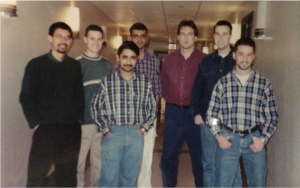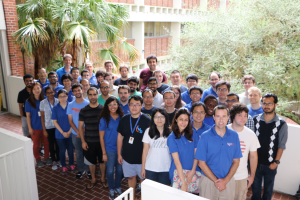The 20-year history of the Interdisciplinary Microsystems Group (IMG) is rich and varied, but it really began with a three-letter acronym and a principle—that the physical co-location of faculty and students from varied backgrounds and disciplines can yield extraordinary results and success. IMG began as an innovation hub, long before the term even existed, and it continues this tradition of innovation twenty years later.
The Interdisciplinary Microsystems Group (IMG) is a college-wide multi-departmental education and research program of the Herbert Wertheim College of Engineering. IMG research focuses on micro- and nano-systems for healthcare, energy, security, aerospace, transportation, consumer electronics, and other industries. Efforts include design, fabrication, characterization, and ultimately deployment of micro and nanotechnologies for a wide variety of applications.
IMG operates under the direction of Mark Sheplak, Hugh Fan, and Saeed Moghaddam of the Department of Mechanical and Aerospace Engineering and Toshikazu Nishida, Huikai Xie, David Arnold, Y.K. Yoon, Jack Judy, Roozbeh Tabrizian and Alexandra Garraud of the Department of Electrical and Computer Engineering (ECE).
The Beginnings
The story of IMG begins with the convergence of Mark Sheplak and Toshi Nishida. They first met when Sheplak, having recently completed his postdoctoral studies at MIT, was interviewing for a position as an assistant professor with the Department of Aerospace Engineering, Mechanics, and Engineering Science (AeMES) * in the fall of 1997. He was ultimately hired and began work at UF on April 1, 1998. At the time, his work was focused on acoustic transducer development, but was plagued by problems of drift and noise in silicon sensors, an area that overlapped with Dr. Nishida’s.
*AEMES merged with Mechanical Engineering in 2003 and became the current department of Mechanical and Aerospace Engineering (MAE).
The two began to work together in earnest, and their common interest in the limits of the emerging field of Microelectromechanical systems (MEMS) led to some interesting ideas. At the time, MEMS was focused on making more than just electronics using semiconductor materials and fabrication methods. Engineers at the end of the last century were looking to use MEMS methodologies to build sensors, actuators, microfluidic devices and more. While today’s iPhone is packed full of MEMS devices, this was groundbreaking stuff twenty years ago.
At the time, in the era of IBM and AT&T, Nishida and Sheplak were sure they’d need a catchy three-letter acronym for their future group. They settled on IMG, for Interdisciplinary Microsystems Group. They envisioned their group as one that would obliterate the usual boundaries between academic and institutional disciplines. Towards that end, they sketched out the idea of a bottom-up, flat organizational structure. They christened this novel interdisciplinary group IMG on April 1, 1998.
The IMG Concept
Nishida and Sheplak knew that if they wanted to expand the boundaries of MEMS, they would need to do some really radical collaboration. They both had first-hand experience with the culture of corporate labs, and they they knew that the traditional, one-professor academic laboratory was not the way to achieve truly ground-breaking results. The interdisciplinary emerging area of micro-electro-mechanical systems and micro-/nano-sensors would require something else. They envisioned a laboratory without walls, where faculty and students from different backgrounds could share their complementary expertise through ad-hoc discussions, usually over coffee. Equipment would be organized by function, not by ‘owner’, and students would be ‘co-located.’
This new vision would require a radical re-imagining of laboratory and office space, since space was traditionally allocated by department. Arranging and allocating space by function, rather than by owner, would eliminate duplication of resources and would give students access to an amazing assortment of fabrication and characterization tools, all located centrally. Personnel would be mixed together, too—an electrical engineer next to a chemist, a biomedical engineer next to a materials scientist. This cross-pollination would create a beehive of activity and catalyze serendipitous discoveries across disciplinary boundaries.
With the IMG concept in place, and with support from ECE and AeMES department chairs and HWCoE Deans, IMG began its steady growth that continues today.

IMG Timeline
1998 The IMG collaboration began in Summer 1998 with the original laboratory in Mark Sheplak’s laboratory in 142 NEB and Toshi Nishida’s graduate office space in 335 Larsen. The first IMG graduate students were Venkataraman Chandrasekaran (AeMES) and Tony Cain (ECE). The first projects were on MEMS for Micro Air Vehicles sponsored by AFOSR and MEMS Based Acoustic Array funded by NASA.
1999 The number of students tripled in 1999, requiring additional graduate office space in NEB 460. One of the new students was David Arnold, who completed his MS in ECE co-supervised by Nishida and Sheplak. He went to GaTech for his PhD, but would return to UF to re-join IMG as a faculty member.
1999 Lou Cattafesta was hired into AeMES in 1999 and joined IMG. His area of expertise was flow control actuators and energy reclamation, as well as flow control systems. He also brought expertise in piezoelectric transducers and energy harvesting. Cattafesta and Sheplak established a new acoustic anechoic chamber in the wind tunnel facility in MAE A 111. New projects on ultrasonic resonators (ONR) and active acoustic liner (NASA) were initiated. Also in 1999, Nishida and Sheplak jointly taught the first MEMS course at UF, Principles of MEMS Transducers.
2002 Huikai Xie was hired into ECE (CMOS MEMS, inertial sensors, micro-optical systems) in 2002. The number of IMG faculty doubled to four faculty (two ECE and two MAE). By this time, IMG had outgrown its space in NEB. With the support of Martin Uman, then-chair of ECE and Wei Shyy, then-chair of AeMES and later MAE, and Pramod Khargoenkar, then-dean of the College of Engineering, the main laboratory of IMG moved to adjacent laboratories in 210 and 214 Benton Hall in late 2002/early 2003. Xie established a biophotonics laboratory in 136 Larsen.
2003 Hugh Fan was hired into MAE in 2003. His interests included physical chemistry, microfluidics, and ‘lab on a chip’ technology). Fan brought with him expertise in biological and medical sensors into IMG and established the microfluidics and bio-MEMS laboratory in the 142 NEB, the original IMG laboratory.
2005 David Arnold was hired into ECE in 2005, tripling the number of IMG faculty to six. Four of the six faculty had offices on the same floor of Benton Hall (Sheplak, Nishida, Xie, and Arnold). Arnold established another IMG laboratory in 215 Benton Hall, focusing on magnetic MEMS. The total number of IMG students now exceeded 50.
2009 Was an important milestone in the growth of IMG. Back in 1998, Sheplak and Nishida began to advocate for improvement of the nanoscale and microscale fabrication infrastructure at the University of Florida. With then-Associate Dean for Research Paul Thompson, they visited nanofabrication facilities at GaTech. Dr. Thompson then became a strong advocate along with then Dean Pramod Khargonekar in securing state funding for what eventually become the Nanoscale Research Facility (NRF), completed in 2008. This freed up space in Benton Hall where the old microfabrication facility had been located. With the support of Dean Cammy Abernathy and ECE Chair Mark Law, a major renovation converted the old microfabrication facility into new laboratories and consolidated the IMG laboratories in the second floor of Benton Hall.
2009 Henry Sodano was hired into MAE in 2009, with his interests in nanocomposites, energy harvesting, and smart materials.
2010 Saeed Moghaddam joined MAE in 2010 (Microheat exchangers, energy storage), and YK Yoon joined ECE in 2010 (RF wireless MEMS and antennas). By 2010, IMG had grown to 9 faculty with 7 of the 9 faculty with offices in Benton Hall across from the IMG laboratories. In 2012, the John Harris, ECE Department Chair, asked for proposals for creating collaborative space. At the time, IMG graduate students were spread out between several graduate student offices in Larsen and Benton Halls. The IMG faculty felt that the students deserved to be close to the IMG labs. A net-zero space proposal was made to move the IMG faculty offices from Benton Hall to Larsen Hall in exchange for a 40 IMG student cubicle space that broke down barriers between students with different IMG faculty advisors. Literally, the walls between the seven faculty offices in Benton Hall were torn down to create one open student space next to the IMG labs. Industry visitors to IMG have been unanimous in their support of the collaborative vision of IMG. Their only question has been the ideal height of the cubicle walls to maximize productivity and collabation.
2013-17 With Jack Judy who joined ECE in 2013 (microscale and nanoscale device fabrication and neural interfaces, director of the Nanoscience Institute for Medical and Engineering Technologies), Roozbeh Tabrizian ECE in 2015 (micromechanical resonators and resonant sensors), and Alexandra Garraud ECE in 2015 (wireless power, bioMEMS), IMG now has 10 faculty members and 90+ members. It is because of the nucleus of IMG that larger efforts such as the NSF Industry/University Cooperative Research MIST Center have been successfully launched. ‘MIST’ stands for Multi-functional Integrated System Technology, and the NSF MIST Center leads the way for developing innovative enabling hardware technologies that serve as the root for Internet of Things smart systems.

IMG Culture
IMG is also known for its fun, family-like environment. For example, every Friday during the summer, 40+ students and faculty gather in the Benton-Larsen courtyard for lunch. What started as a few IMG students occasionally cooking burgers has grown into an international food faire, with groups of students preparing a regionally inspired lunch (sometimes even with music for ambiance!). The best offering is awarded a “golden spatula” award.
To effectively coordinate such a large operation, it comes down to one important factor—communication. IMG Faculty meet casually for lunch once per week, and there are numerous internal student committees to keep things running smoothly.
IMG has an internal motto, “Give a little, get a lot,” verbalizing the collaborative spirit that has guided IMG from the beginning. The spirit has served well for the past twenty years, and will undoubtedly power IMG’s future.
IMG By the Numbers
Since 1998:
- Participated in 290 sponsored research projects valued at $95M (IMG portion was $51M)
- Of 290, 228 projects (78%) were led by an IMG faculty member as PI, and 71 (25%) included more than one IMG investigator
- More than 110 Ph.D. graduated
- More than 80 M.S. graduated

